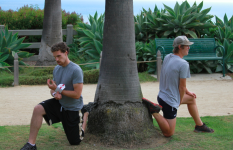
I get this question all the time: “When should I stretch?” This is definitely a very important question, and one well worth the time. Mobility is probably one of the most avoided pieces of quality training habits. I am just as guilty as the next athlete of not holding myself to a mobility regimen. First lets be clear, your ability to increase your fitness is directly related to your ability to recover from the workouts you perform. Recovery includes hydration, sleep, nutrition, and, of course, mobility. If you are not concentrated on your recovery, you are definitely leaving a lot on the table with regards to your potential.
For simplicity, I want to break down mobility into two different parts…
1. Activations are those things that you do to ‘turn on’ your muscles. It is very important before expect your body to perform, that you prepare the muscles and joints that are going to be involved. Your body is an amazing machine, but it needs to be ready to go. Think of an Olympic level sprinter. He/she will warm up for well over 45 minutes for a race that takes less than a minute to run. Now, they are at the highest level, working at maximal speeds, and maximal ranges of motion, but you get the point. Think of your workout as your chance to perform, you only have this one body. You might as well take care of it.
Activations bring blood flow to the muscles that are involved, and can help an athlete identify where they should feel an exercise. A glute bridge, for example, is a good activation for a day of deadlifts due to its concentration on the glutes and hamstrings. Having some go to activations that work for you is largely beneficial. If you are not sure of some good activations, let your coach know. There is by no means an end-all-be-all activation. They vary with application and circumstance. Activations are to be done leading up to a workout.
2. Stretching is very productive after the workout has taken place. Your muscles are in a state of fatigue, and could use some assistance into the cycle of recovery. Stretching is very commonly mistaken for activation before a workout. A cold muscle, or relatively inactive muscle is going to be a stubborn muscle to stretch. So, right when you walk into the gym, stretching may be a misuse of time. On the other hand, activations would be a very worthy use of your time. Think about activations as movement done to prep muscle recruitment (good mornings), and during stretches you would be holding a position (reaching for your toes). There are so many stretches, and all vary depending on the athlete. It is a good idea to have some go-to’s here, as well. If you have questions, ask your coach, we will be happy to help.
Now there are activations that are also stretches, and things such as yoga could be considered stretching that is also activating. The important part is not the black and white of the two. Instead, it is that you understand how to prepare your body for the activities that you participate in, and also care for your body after you do these things. This is a small piece of the puzzle, but a very necessary one. Mobility is a very beneficial area to spend time in. Try spending 10 min every day mobilizing. Cheers to more mobility, and healthier bodies.
Danny Lesslie
———————
Thursday’s Workout:
EMOM 10
Even: 8 Depth Pushups
Odd: 8 KB Bent Row Each
Then, complete the following for time:
50 Rack Lunges (53/35)
400M Run

